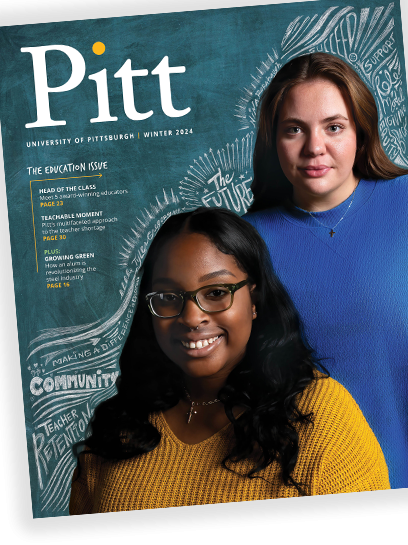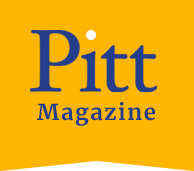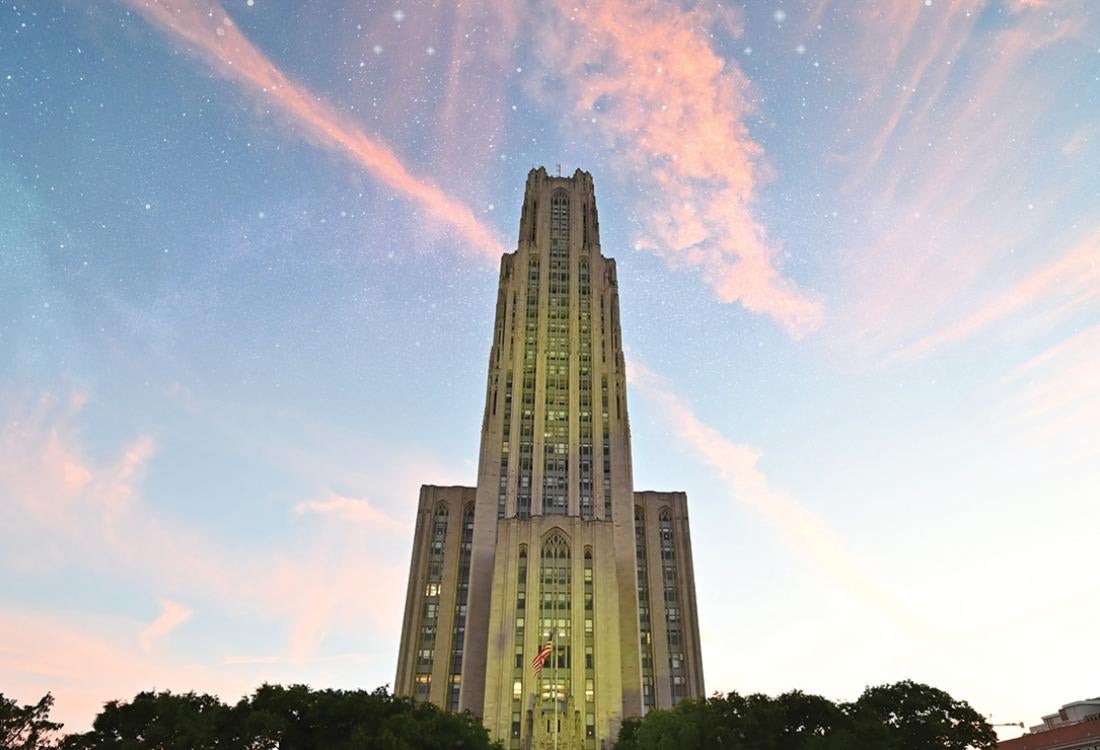
Joan Gabel wasn’t the first person in her family to choose the University of Pittsburgh.
Years before a chancellorship hiring committee was assembled, before Gabel threw her hat into the competitive ring, before a rigorous interview process led to naming her Pitt’s 19th chancellor, Gabel stepped onto the Pittsburgh campus as the parent of a student.
“I did it in reverse,” she jokes.
It was 2019, and Gabel’s youngest son, a burgeoning computer scientist, was on the hunt for the right university. Using his already well-honed programming skills, he wrote an algorithm to identify his ideal school. When the criteria were entered and results spun out, the University of Pittsburgh was at the top.
To validate those results, the Gabel family flew from Minnesota to Pittsburgh for a campus visit. It confirmed what the algorithm already knew — Pitt was the place for him.
Gabel was impressed with what she saw, too, but not surprised. As president of the University of Minnesota and with decades of higher education experience, she was already familiar with the University of Pittsburgh’s reputation as a top-tier institution. When she became a Pitt parent, however, she gained a new appreciation for her son’s chosen school.
By the time Gabel was appointed University of Pittsburgh chancellor in the spring of 2023, she had already walked the campus, paid tuition and heard about the professors and their courses. She’d watched, in admiration, as the community came together while the COVID-19 pandemic surged. And she’d witnessed the transformative effect of a Pitt education.
Still, new discoveries during her busy and vibrant first months on the job left Gabel astonished, again and again: research dollars funding treatments and cures, teams of experts exploring ways to make lives better for nearby communities, students realizing their goals.
“It was one revelation after another,” she says.
A mantra soon began to form in her head, one that recognized Pitt’s prowess and differentiated approach: “It’s Possible at Pitt.”
It’s a truth she knows both in her experience as a parent and as the University’s energized, forward-thinking leader. Gabel’s embrace of Pitt’s boundless possibilities has served as the driving force behind her first months in office.
It’s reflected in the bold and thoughtful approach she is taking; in the long-standing objectives she’s supporting and cultivating; in the connections she’s making with students, faculty, staff and alumni; and in the communities and broader region that Pitt serves.
It takes center stage in Gabel’s work with students, faculty, staff, alumni, supporters and partners to develop the Plan for Pitt 2028 — the University’s blueprint for the future — where an adherence to the highest ideals of higher education melds with methods to enable the University to seize an even brighter, more impactful future.
Pitt has long been a place where bold leaps and expertise combine to create tangible solutions for some of society’s biggest challenges.
Look no further than Jonas Salk, who developed his lifesaving polio vaccine at Pitt in the 1950s, or Thomas Starzl, who performed the world’s first double organ transplant here in 1984, or Wangari Maathai (A&S ’65G), who received a strong foundation in global affairs at the University before going on to win a Nobel Peace Prize for her human rights work in Kenya.
Gabel’s goal is to ensure that standard of excellence continues well into the future, and one of the ways she hopes to accomplish that is with a values-driven strategic plan.
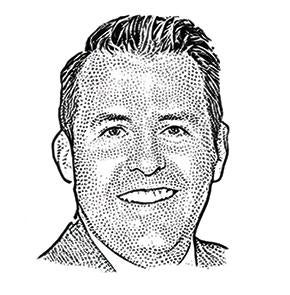
For Gabel, strategic plans are tools that provide inspiration, accountability and a collective vision for the future, says Bill Haldeman, Pitt’s vice chancellor and chief strategy officer. He’s worked with Gabel at three different institutions, and at each one, he’s been impressed by her capacity to understand the character of the community, set a vision, generate buy-in and, ultimately, reap results.
“She has the ability to take what is an existing strength and elevate it to a true distinction,” he says.
At Pitt, Gabel’s dedication to bold leaps led her team, in consultation with shared governance, to allocate an entire section to them in the University’s revamped strategic document. Fittingly, Gabel named that section, or imperative, “It’s Possible at Pitt.” The name reflects how, if the University doubles down on areas where it has unique strengths, real opportunity and innovative thinking, then it is possible to bring together communities, identities and cultures on campus, throughout Pittsburgh and around the world for the good of all.
Examples of such opportunity and innovation can be found across campuses and disciplines.
Distinguished Professor Rory Cooper’s celebrated, careerlong crusade to invent and improve technology that makes movement easier for those with disabilities — including a robotic arm extension and a wheelchair powered by compressed air — is one.
The Pittsburgh Quantum Institute is another. There, researchers study the world’s tiniest scientific systems to yield big results, like Professor Lillian Chong’s simulations that mimic biological processes too small and fast to be seen with a microscope, including an atomic-level view of how the coronavirus that causes COVID-19 attacks the body.
Gabel’s vision is to open even more doors for this kind of groundbreaking work at Pitt and to help create and support new avenues for innovation, like Pitt BioForge.
With BioForge — the 185,000-square-foot biomanufacturing center that will soon break ground in Greater Hazelwood in Pittsburgh — Pitt stands at the precipice of biological advancements that could reshape the way scientists think about and respond to pressing issues like disease and sustainability. The facility will allow researchers and industry leaders to develop and commercialize the life-enhancing technologies, drugs and therapies that address those issues.
There, Leah Byrne, an assistant professor of ophthalmology in the School of Medicine, will be able to produce the materials she needs to take her work to trial. Byrne’s research involves delivering snippets of DNA directly to cells in the retina, which may treat a wide variety of retinal diseases and help patients regain lost vision.
“What's happening in life sciences, organic science, is poised to be the absolute next generation of innovation,” Gabel says.
BioForge will help keep Pitt and Pittsburgh on the leading edge of it all.
Already, the Richard King Mellon Foundation has committed $100 million to the cause, calling it “a generational opportunity” with the potential to improve lives across the region through economic development, job creation and lifesaving innovations.
While Gabel keeps her eye on these change-making efforts, they are only part of her vision for what’s possible at Pitt, now and in the future. She’s also doubling down on the basics like academic excellence and cultivating student success — objectives that have been at the core of the University since its founding in 1787. To Pitt’s new chancellor, shooting for the stratosphere and recommitting to long-established priorities are two sides of the same coin.
“She respects the history of a place,” Haldeman says. “You don’t want to lose who you are at your core because you’re pushing the envelope too much in certain areas. She’s someone who’s able to thread the needle and find the right balance between innovation and tradition.”
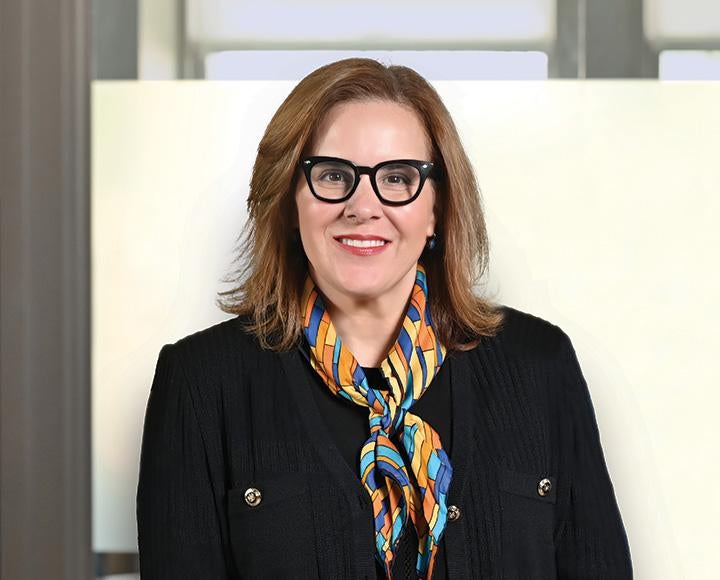
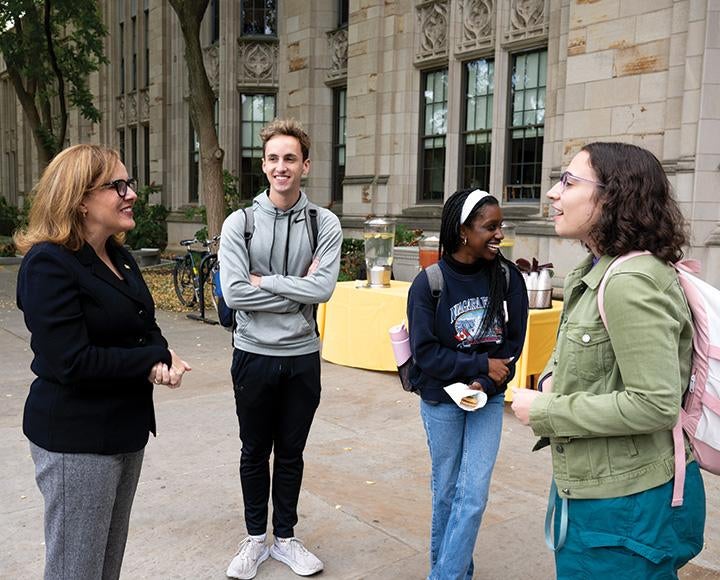
It comes as no surprise to those who know Gabel well that her plans for Pitt’s future are both bold and prudent. In fact, they would expect nothing less from someone who has lived as both a gutsy adventurer and a thoughtful planner.
Gabel was born in New York state, the daughter of a government employee and a Pan Am flight attendant, who later became a speech pathologist. Because her father’s job required the family to move frequently, and her mother held a firm belief that you bloom where you’re planted, Gabel quickly adopted a hunger for travel and adventure.
Feeding that appetite would introduce Gabel to multiple countries, cultures and experiences over the decades, including family trips around the globe, summers spent teaching in Northern Italy and a fellowship through the Fulbright U.S. Scholar Program to study higher education practices in India.
But in those early years, it also led her to think in the short term, she admits. Her focus fixed firmly on the next class, the next flight, the next step in her thriving law career, but rarely far beyond.
That all changed in 1996, when Gabel, looking for a deeper connection to her work and more space for her family, made the decision to change her trajectory.
It was what she calls a “tap on the shoulder” moment — a stroke of serendipity that upends the status quo. This one occurred when a mentor asked, just as Gabel was pondering professional change, if she had ever thought about teaching. The idea of helping students mold their own law careers, rather than advancing her own, immediately intrigued her.
While Gabel found that academia suited her, she also realized her new career would require the ability to ponder decisions and ideas with more breadth and depth than she had previously allowed herself.
“The professional arc of a faculty member requires you to have a linked, thoughtful, deepening path that you have to anticipate, even if you occasionally pivot from that path over time,” she says.
That amended way of thinking and planning also generated a host of new opportunities. Over the next two decades, Gabel carved a career that took her to some of the country’s top public universities — including Florida State, Missouri, South Carolina and Minnesota — and earned her increasingly influential titles: department chair, dean, provost and president.
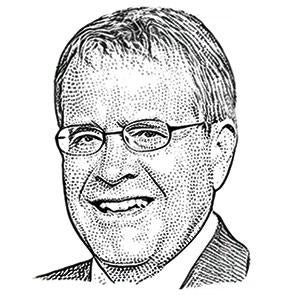
Jere Morehead, who taught Gabel when she was a law student at the University of Georgia and now serves as its president, watched her rise with much admiration but little surprise.
“She can take an issue or a problem, pick it apart and figure out the strengths and weaknesses of any argument,” he says. “When others might just step back and say, ‘Oh, this issue can't be fixed,’ she'll figure out a way to fix it. And in higher education today, figuring out paths forward is crucial.”
But as she rose steadily through the ranks of academia, she watched the space between her office and the classroom widen. To soften the loss of those daily, spontaneous interactions with students that she cherished — and to continue supporting student wellness — Gabel focused on making an impact through the students she saw often, namely those in student leadership.
Taylor Wright — now a senior adviser for public engagement at the White House — served as student body president at the University of South Carolina in 2019 when Gabel was provost. He immediately admired her: the lone woman at the leadership table who used her voice and position to elevate important issues.
“I remember feeling engaged and inspired by her; as a student, that’s not something you always feel from an administrator,” Wright says.
He got an up-close view of her tenacity during his senior year, as he fought to implement a student fee transparency initiative at the Columbia, South Carolina, university. When other administrators appeared to rebuff his efforts, he turned to Gabel, who immediately convened a meeting of the school’s deans to discuss the plan’s merits. Shortly thereafter, the initiative passed.

“If it makes sense, if it’s practical, if it’s good for students, she’s going to make it happen,” Wright says.
It’s what Gabel refers to as the “multiplier effect” — her capacity as an administrator to alter circumstances for many students at once, rather than one at a time.
One such example at Pitt is the Finish Line Grant, which Gabel announced on her 100th day in office. The grant offers one-time, nonrenewable grants to eligible students with financial holds or unpaid balances so they can stay enrolled and complete their degrees.
According to Gabel, the key to any impactful student program or interaction — whether individual or on a larger scale — is to see students as whole, nuanced human beings and not just degree seekers.
“Students are in class two, three, five hours a day,” Gabel points out. “There’s the whole rest of the day that they are living, learning and growing. How are we facilitating that for them? Are they feeling supported? Are they able to ask questions? Are they able to change their minds? Are they able to meet people who expand their horizons? We need to be thinking of the total student and be certain we’re serving them in the ways that they need.”
Sometimes, as Gabel proved early on at Pitt, those ways are both simple and hugely impactful.
Back in August 2023, on the eve of the fall semester, Pitt senior Madelynn Lederer took her place on the Cathedral of Learning lawn. As president of the Blue and Gold Society, a student ambassador group, she’d been asked to address a crowd of first-years and explain the century-long tradition of Lantern Night, when the “light of learning” passes from one generation of Pitt students to the next in a candlelit ceremony.
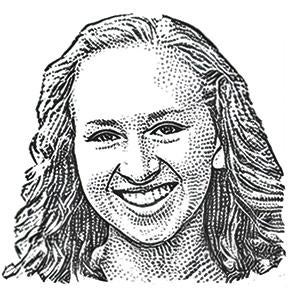
She was both delighted and a bit nervous to find herself seated next to Gabel. Fortunately, Lederer had the perfect conversation starter. She was applying to law schools, and Gabel had, of course, been through the grueling process herself.
As they waited for students to assemble and the sky to darken, Lederer and Gabel amiably chatted. Lederer rattled off the curated list of schools to which she would apply — and revealed the one she was still contemplating: Harvard. Despite her stellar grades and leadership record, Lederer worried the ultracompetitive school was too much of a reach and maybe not even worth an application.
Gabel dismissed those doubts with an urgent shake of her head. Lederer’s academic accomplishments at Pitt made her a solid candidate.
“Apply,” Gabel insisted. “This is possible.”
Buoyed by the chancellor’s words and armed with glowing recommendations from professors and mentors, Lederer sent in her application. Five months later, the admissions office at Harvard Law reached out with its decision: Lederer was in.
She wanted to tell the chancellor her news, but worried their interaction was just one among hundreds the chancellor experienced in her first weeks on the job. Still, she couldn’t help but take the opportunity when Gabel attended a Blue and Gold Society meeting this winter. When the event’s business had concluded, Lederer approached the chancellor with restrained excitement to tell her of Harvard’s decision.
Gabel showed no such restraint. Her hands flew to her mouth for a moment before she reached out to pull Lederer into a hug.
“It meant so much that she encouraged me to apply and then that she remembered encouraging me,” reflects Lederer. “It’s nice to have someone in her role who is so invested in the individual achievements of students.”
That kind of care and investment, says South Carolina alumnus Wright, is just Gabel’s way.
“She’s laser-focused on doing good for students and for the community at large,” he says. “She’s a person who can always be fully trusted to stand up and speak out about things that matter.”
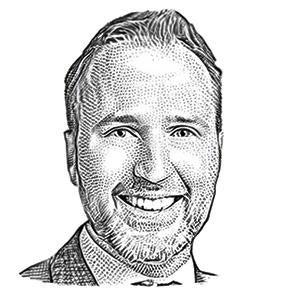
Kevin Washo, Pitt’s senior vice chancellor for university relations and Gabel’s chief of staff, recognized the chancellor’s humanity on her very first day at Pitt.
He accompanied her as she worked through an airtight, dawn-to-dusk schedule of interviews, meet-and-greets and photo opportunities. They were both exhausted by the time they left their last engagement at the University Club to walk back to their offices at the Cathedral of Learning. But Gabel still had enough energy and interest to inquire about Washo’s background—he is a Pitt alumnus and former trustee — and family.
In that moment, Washo says, he knew she was the right choice for Pitt.
“As someone who’s worn a lot of hats at Pitt and who cares about this place very deeply, I think the University is in tremendous hands,” Washo says. “Chancellor Gabel is someone who understands the academy and how to run a big organization, and she’s someone who understands the importance of what Pitt means in the community. It’s not an easy combination to find, and I think Pitt’s future is bright with her at the helm.”
As she prepares to begin her second year in office, Gabel continues work on the Plan for Pitt 2028 and the related initiatives already in motion. She’s led — just as she was on her first day — by both a thoughtful appreciation for the University’s past and a boundless enthusiasm for its potential.
Addressing Pitt’s Board of Trustees in February, Gabel said: “I can say, having arrived relatively recently, that Pitt's national reputation is extremely strong. But there is a wide-held belief — that I agree with — that the reality is even better than that reputation. We want to close that gap. We want the world to know about the amazing things that we're doing. We want to lean into our distinct strengths, take strategic risks and invest in things that we can uniquely do well.
“There’s so much more to come.”


